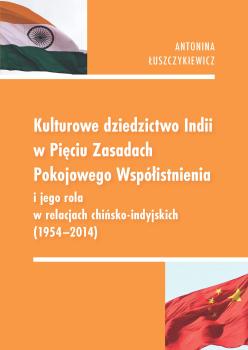Kulturowe dziedzictwo Indii w Pięciu Zasadach Pokojowego Współistnienia i jego rola w relacjach chińsko-indyjskich (1954–2014)
Keywords:
China, India, Five Principles of Peaceful Coexistence, border conflict, cultural heritageSynopsis
CULTURAL HERITAGE OF INDIA IN THE FIVE PRINCIPLES OF PEACEFUL COEXISTENCE AND ITS ROLE IN CHINESE-INDIAN RELATIONS (1954–2014)
This monograph is devoted to the political and cultural discourse related to the Five Principles of Peaceful Coexistence — also known as Pancha Shila (pañca śīla) — formulated for the first time in the Chinese-Indian Agreement of April 29, 1954. This agreement expresses the will to develop cooperation between Tibet (annexed by the People’s Republic of China in 1950) and the Republic of India. It also regulates various issues related to trade and pilgrimage. The principles contained in the preamble to the agreement include: mutual respect for the territorial integrity and sovereignty of each state, mutual non-aggression, mutual non-interference in internal affairs, equality and mutual benefits, as well as peaceful coexistence. The monograph offers a completely new view on this international agreement. While the vast majority of academic texts devoted to the Five Principles were written from the perspective of political science, the research conducted in this work incorporated a cultural studies approach. The subject of the study are books, articles, speeches and interviews which express the view that the Five Principles echo the ancient Indian attachment to peace, non-violence, and even tolerance towards other philosophical and religious systems. Therefore, the main aim of this publication is to reconstruct the cultural discourse according to which the ideas embodied in the Five Principles were to reflect the values rooted in the Indian civilization. In other words, this research serves not so much to show the Five Principles as a set of values characteristic of Indian culture, but rather to uncover why and how politicians, journalists, and even academics have ascribed a cultural sense to these principles. This work also attempts to explain why, as part of this peculiar re-semantization and re-contextualization, the creators of the Five Principles discourse only applied selected historical and cultural issues, and how, for six decades, they have used this narrative manipulation to achieve ideological and image-building goals. As a result, this monograph can be treated as a study of activities consisting in the legitimization of political constructs through alleged connections with a mythologized and sanctified past.
Chapters
-
TABLE OF CONTENTS
-
Uwagi dotyczące zapisu .......... 11
-
Wstęp .......... 13
-
Rozdział 1. Pięć Zasad w kontekście historycznym
-
1.1. Relacje chińsko-indyjskie – krótki rys historyczny .......... 35
-
1.2. Rola Pięciu Zasad w politycznym wymiarze relacji chińsko-indyjskich .......... 56
-
Rozdział 2. Pięć Zasad w kulturowych interpretacjach
-
2.1. Analiza tekstów poświęconych Pięciu Zasadom z lat 1954–1962 .......... 121
-
2.2. Analiza tekstów poświęconych Pięciu Zasadom z lat 1962–1988 .......... 169
-
2.3. Analiza tekstów poświęconych Pięciu Zasadom z lat 1988–2014 .......... 222
-
Rozdział 3. Rekonstrukcja kulturowego dyskursu Pięciu Zasad
-
3.1. Historyczno-kulturowe aspekty Pięciu Zasad w polityce Jawaharlala Nehru .......... 269
-
3.2. Kulturowe warstwy interpretacji Pięciu Zasad .......... 273
-
3.3. Krytyczna analiza kulturowego dyskursu Pięciu Zasad .......... 292
-
Zakończenie .......... 315
-
Aneks. Dziedzictwo cywilizacyjne Indii .......... 323
-
Mapy .......... 381
-
Bibliografia .......... 383
-
Indeks osobowy .......... 413
-
Indeks geograficzny .......... 421
-
Indeks tematyczny .......... 425





